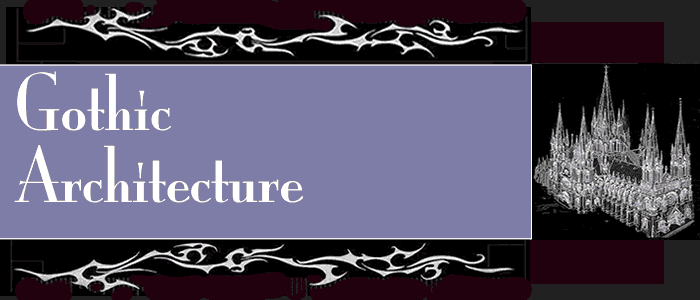|
Gothic Glossary
~ Abbey
A church that is or once was part of a religious community.
~ Arch
A structure that fills the upper edge of an open space and is designed
to support the weight above it.
~ Cathedral
A church that is seen as both large and important.
~ Columns
Cylinder shaped pillars that support architecture structures.
~ Crockets
A design that is shaped like a curled leaf. They are usually created to
decorate the outer angles of pinnacles.
~ Curvilinear
This is the Latin word meaning curved and linear. This term refers to
any curved lines.
~ Fan Vaulting
A series of arched structures used to decorate and cover a space. These
architectural creations are built from cut stone and are made up of many
of inverted cone shapes. This architectural piece forms a fan shape that
consists of projected markings called ribs.
~ Foliage
A decorative representation, applied specifically to architectural structures,
of plant life.
~ Flying Buttress
A structure that is used to reinforce a building and that is usually made
of brick or stone. Flying Buttresses stand apart from the main structure
but are connected to it by an arch.
~ Gothic Architecture
A specific style of architecture that originated in France but spread
throughout Europe between the 12th-16th centuries. Gothic Architecture
is viewed as a prominent medieval style of architecture in Europe.
~ Hammerbeam roofs
A specific structural design used in ceilings where horizontal beams are
raised into the interior of a ceiling and serve the purpose of supporting
the top of a structure.
~ Monarch
One who rules over a nation and has considerable power. Usually this term
is applied to one who has gained this title by a hereditary right.
~ Neo-Gothic Architecture
This is seen as a more modern revival of gothic architecture. This style
of architecture was inspired by the original gothic architecture but has
expanded to the western world and is not specific to structures related
to religion as gothic architecture is.
~ Norman Architecture
The design style that was originated by the Romans in 950 AD. This architectural
style tends to consist mostly of round shaped structures.
~ Ogee
Curves that come together at a point to form an arch and that are in two
S-shapes.
~ Paneling
A series of flat tiles used to raise an area within a structure. This
creates a decorated and framed look around the area of the building where
the tiles are placed.
~ Perpendicular
Any lines that form right angles. When related to gothic architecture
it is a specific period that focuses on the element of vertical lines
in structures.
~ Pinnacles
The top of a pointed peak located on the roof of a structure.
~ Spire
A tall tower that comes to a steep point and is located at the top of
a large architectural structure.
~ Trefoil
A symbol used in architectural designs that resembles a certain type of
leaf known as the trifoliate leaf.
HOME
|





